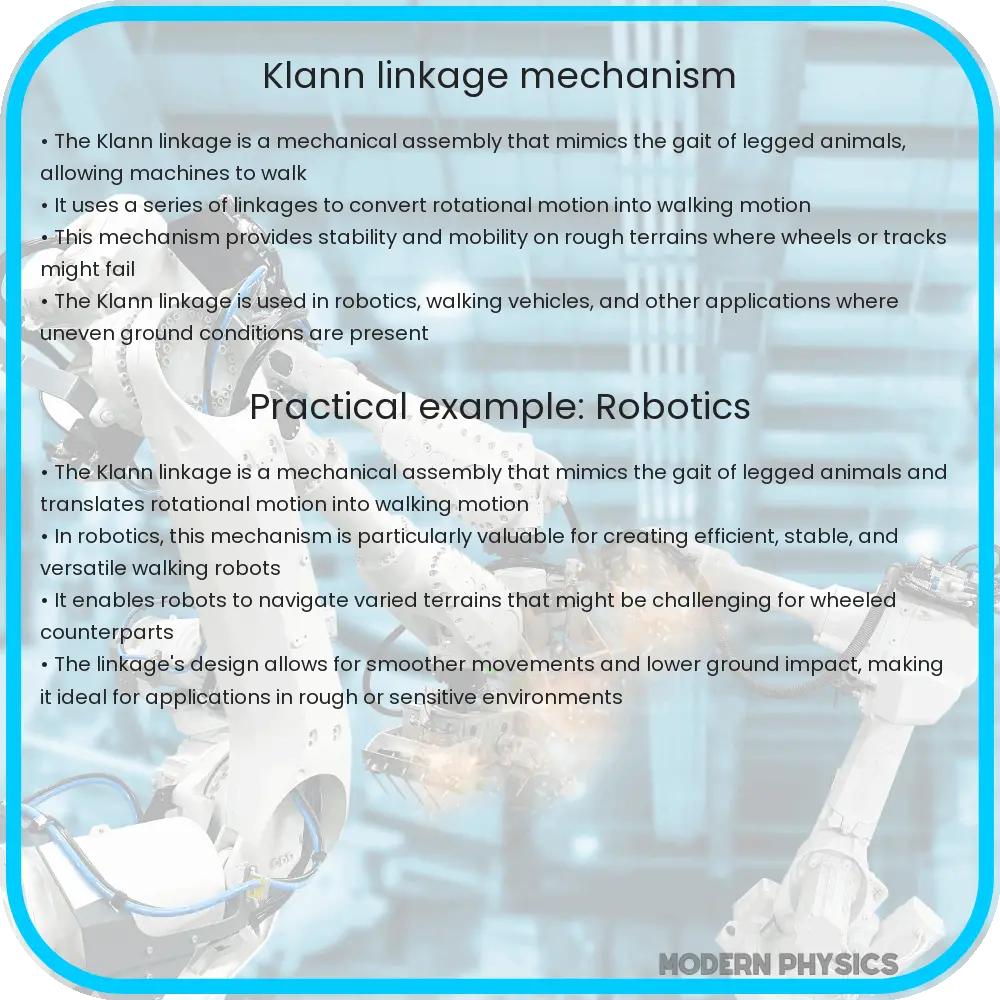Explore the Klann Linkage Mechanism’s efficiency, dynamics, and design, its role in robotics and prosthetics, and future innovation potentials.

Understanding the Klann Linkage Mechanism
The Klann Linkage Mechanism is an innovative and complex system used in mechanical engineering to simulate the gait of legged animals. This mechanism is a significant advancement over traditional wheel-based locomotion, especially in rough or uneven terrains. The Klann Linkage offers enhanced efficiency, dynamics, and design flexibility, making it ideal for applications in robotics, machinery, and even art installations.
Efficiency of the Klann Linkage
One of the key advantages of the Klann Linkage is its efficiency in converting rotary motion into linear motion. This efficiency stems from its ability to mimic the smooth and natural movement of legged creatures. By replicating this biological efficiency, the Klann Linkage reduces energy consumption and enhances the operational efficiency of the systems it is integrated into. This aspect is particularly important in applications where energy conservation is paramount, such as in battery-operated robotic systems.
Dynamics of the Klann Linkage
The dynamic capabilities of the Klann Linkage set it apart from other motion systems. Its unique design allows for a wide range of movement, enabling the mechanism to traverse various types of terrain with ease. This adaptability is attributed to its multiple joints and linkages, which work together to provide a fluid and stable motion. In robotics, this means the ability to navigate over obstacles and uneven surfaces, which is a significant advantage over wheeled counterparts.
Design Considerations for the Klann Linkage
Designing a Klann Linkage requires careful consideration of various factors. The size and length of the linkages, the number of joints, and the overall geometry of the system play crucial roles in determining the efficiency and effectiveness of the mechanism. Material selection is also critical, as it directly impacts the durability and weight of the system. For instance, using lightweight and strong materials like aluminum or carbon fiber composites can significantly improve the performance and lifespan of the mechanism.
In the next section, we will delve deeper into the applications and potential developments of the Klann Linkage mechanism, exploring how it is revolutionizing the field of mechanical engineering and beyond.
Applications of the Klann Linkage Mechanism
The versatility of the Klann Linkage Mechanism extends to various fields. In robotics, it enables more effective and adaptable robots, particularly in search and rescue operations where traversing complex terrains is essential. The mechanism is also used in the entertainment industry, creating life-like movements in animatronics. Additionally, in the field of prosthetics, the Klann Linkage offers new possibilities for creating more natural and efficient limb replacements, greatly enhancing the quality of life for amputees.
Potential Developments and Innovations
Looking forward, the potential for innovation with the Klann Linkage is immense. Integration with advanced materials and smart systems, like AI and IoT, could lead to even more efficient and adaptive mechanisms. For example, AI integration can enable real-time terrain analysis and adjustment of the linkage movement for optimal efficiency. Furthermore, the incorporation of IoT technology could allow for remote monitoring and control of systems equipped with the Klann Linkage, expanding their usability in hazardous or inaccessible environments.
Challenges and Considerations
Despite its advantages, the Klann Linkage Mechanism faces challenges. The complexity of its design and the precision required in manufacturing its components can lead to higher production costs. Additionally, ensuring the durability and reliability of the mechanism over time, especially under varying environmental conditions, remains a significant concern. These challenges necessitate ongoing research and development to refine the design and materials used in the Klann Linkage.
Conclusion
The Klann Linkage Mechanism stands as a remarkable example of biomimicry in mechanical engineering. Its ability to efficiently convert rotary motion into linear, animal-like movement has opened new horizons in robotics, prosthetics, and beyond. While challenges exist in terms of complexity and cost, the continuous advancements in materials science and technology promise to further enhance the capabilities of this innovative mechanism. As we move forward, the Klann Linkage is poised to play a significant role in the evolution of motion systems, potentially transforming how machines interact with their environment.
